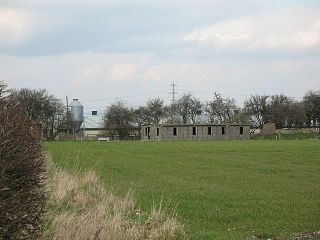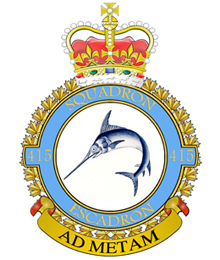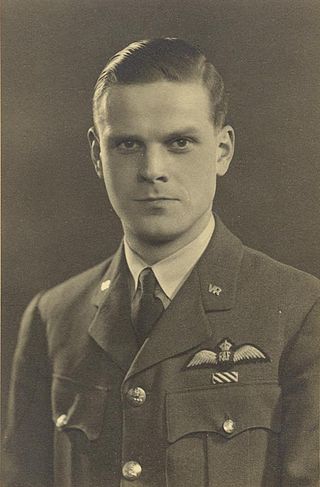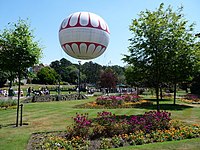
The Short Stirling was a British four-engined heavy bomber of the Second World War. It has the distinction of being the first four-engined bomber to be introduced into service with the Royal Air Force (RAF).

Royal Air Force Leeming or more simply RAF Leeming is a Royal Air Force station located near Leeming, North Yorkshire, England. It was opened in 1940 and was jointly used by the RAF and the Royal Canadian Air Force (RCAF). Between 1950 and 1991, it operated mostly as a training base with Quick Reaction Force (QRF) Panavia Tornado F3 fighters based there in the latter stages of the Cold War and into the early 21st century. Since 2006, it has become the home of the deployable RAF communications cadre and the home of No. 135 Expeditionary Air Wing.

The Royal International Air Tattoo (RIAT) is the world's largest military air show, held annually in July, usually at RAF Fairford in Gloucestershire, England in support of The Royal Air Force Charitable Trust. The show typically attracts a total of 150,000 to 200,000 spectators over the weekend.

Bournemouth Airport is an international airport located 3.5 NM north-northeast of Bournemouth, in southern England. The site opened as RAF Hurn in 1941, but was transferred to civil control in 1944. For a short period Hurn served as London's international airport, until the opening of facilities at Heathrow. Commercial services resumed in the late 1950s, with Palmair commencing flights to Palma, Majorca in October 1958.

Royal Air Force Polebrook or more simply RAF Polebrook is a former Royal Air Force station located 3.5 miles (5.6 km) east-south-east of Oundle, at Polebrook, Northamptonshire, England. The airfield was built on Rothschild estate land starting in August 1940.

No. 466 Squadron RAAF was a Royal Australian Air Force (RAAF) bomber squadron during World War II. Formed in the United Kingdom in late 1942, the squadron undertook combat operations in Europe until the end of the war, flying heavy bomber aircraft. Following the conclusion of hostilities with Germany, the squadron began retraining to undertake operations in the Pacific against the Japanese, but the war came to an end before it left the UK. In late 1945, the squadron was disbanded.

RAF Tholthorpe was a Royal Air Force air station operated by RAF Bomber Command during the Second World War. The station, which had been opened in the late 1930s as a grass airfield, was located near Easingwold, North Yorkshire, UK. Tholthorpe airfield operated as a sub-station of RAF Linton-on-Ouse.

Harrogate (Stonefall) Cemetery is a Commonwealth War Graves Commission (CWGC) burial ground for the dead of the First World War and Second World War located on the outskirts of Harrogate in North Yorkshire, England.

415 Long Range Patrol Force Development Squadron is an air squadron of the Royal Canadian Air Force that first saw service during the Second World War.

Pilot Officer Cecil Henry Hight was a New Zealand born fighter pilot who served with the Royal Air Force during World War II. He was killed in action during the Battle of Britain.
This is a partial list of accidents and incidents involving the Boeing-designed B-17 Flying Fortress. Combat losses are not included except for a very few cases denoted by singular circumstances. A few documented drone attrition cases are also included.

Wing Commander Peter Stanley James, was a pilot in the Royal Air Force Volunteer Reserve during the Second World War, flying in RAF Bomber Command with No. 35 Squadron, No. 78 Squadron and No. 148 Squadron.

On 23 April 1945, a Boeing B-17G Flying Fortress crashed on North Barrule, a hill in the Isle of Man. A total of 31 people were killed. The accident is the deadliest aviation accident to have occurred in the Isle of Man. It was due to controlled flight into terrain (CFIT).
Moordown is a suburb of Bournemouth, situated in the northern part of the borough. It was incorporated into the borough of Bournemouth in 1901, having previously been part of the Christchurch rural district.
The Mi Amigo memorial is a war memorial at Endcliffe Park, Sheffield, England, marking the World War II crash site of the USAAF B-17 Flying Fortress Mi Amigo.

Flight Lieutenant David Murray Peden was a Canadian air force officer, lawyer, and author. From 1941 to 1945 Peden served in the Royal Canadian Air Force as a bomber pilot and completed the majority of his tour of duty with No. 214 Squadron of RAF Bomber Command. Following the war he returned to Canada and became a lawyer in Winnipeg. Later in life he authored three books. He is best known for his 1979 memoir A Thousand Shall Fall, which former director of the Canadian Army Historical Section, C. P. Stacey, called "the best book any Canadian has written about his war experiences, and one of the best books about the war that has been written anywhere."
Events from 1944 in England

Flight Lieutenant Jon Egging was a Royal Air Force pilot on the Red Arrows aerobatics display team, who died after crashing into a field in Throop, Dorset. The incident occurred after a display at the Bournemouth Air Festival in Bournemouth, Dorset. It was determined that Flt Lt Egging was incapacitated due to the effects of g-force induced loss of consciousness until very shortly before impact. Egging was the first Red Arrows pilot to die in an aircraft crash in the 21st century, since Flt Lt Neil Duncan MacLachlan, in 1988.















